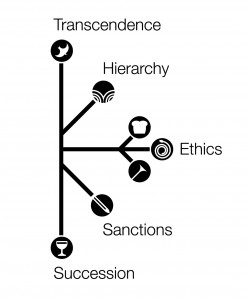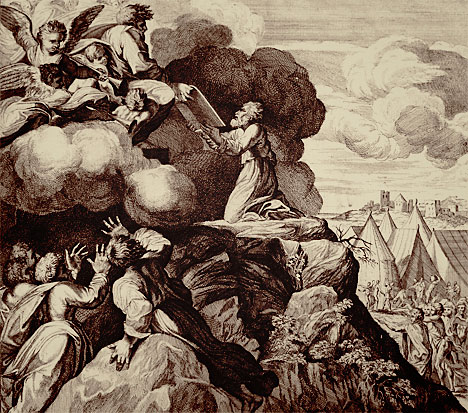Q&A: Sin, Righteousness and Judgment
In John 16:7-11, we read:
Nevertheless, I tell you the truth: it is to your advantage that I go away, for if I do not go away, the Helper will not come to you. But if I go, I will send him to you. And when he comes, he will convict the world concerning sin and righteousness and judgment: concerning sin, because they do not believe in me; concerning righteousness, because I go to the Father, and you will see me no longer; concerning judgment, because the ruler of this world is judged.
What does it mean for the Spirit to “convict the world in regard to righteousness?” And what is the causal connection with Jesus going to the Father?
The phrase “sin, righteousness and judgment” refers to a threefold legal process found throughout the Bible. By Covenant, God chooses and qualifies His representatives.
The threefold legal process relates to the Creation Week because it moves from a “forming” to a “filling” and then to a “future.”
The Covenant pattern itself is fivefold:
TRANSCENDENCE (who’s the boss?)
…..HIERARCHY (whom has He put in charge?)
……….ETHICS (what are we to do?)
…..SANCTIONS (what will we get?)
SUCCESSION (when is He coming back?)
However, this pattern contains the “forming, filling, future” structure of the Creation week:
Transcendence and Hierarchy are the “forming,” as uncreated authority is delegated to a representative. Yahweh is the cause and His representative is the effect.
Ethics and Sanctions are the “filling” of the Covenant. Here, the Laws are the cause and the blessings/curses are the effect.
In each case, as cause becomes effect, “word” becomes flesh. The forming concerns the establishing of the legal parties and the filling concerns the expression of their relationship. It is a “head” and a “body.”
Finally, Succession concerns the “future.” Those who understood that the Ethics were intended for good and not evil (as Joseph did, and Adam didn’t), are given greater authority, just as Jesus promised.
The “forming, filling, future” process found not only within the entire Covenant pattern, but “fractally” within the Ethics step on its own.
The Law is given; the Law is opened; the Law is received. These three steps are the revelation of the Ethics of the Covenant as the beginning of a New Creation.
 Aligned with the Bible Matrix, you can see that the Law is given at Ascension (Moses on the mountain as Firstfruits), the Law is opened at Testing (Pentecost), and the legal witness by (or against) Israel is received at Maturity (Trumpets).
Aligned with the Bible Matrix, you can see that the Law is given at Ascension (Moses on the mountain as Firstfruits), the Law is opened at Testing (Pentecost), and the legal witness by (or against) Israel is received at Maturity (Trumpets).
This threefold process is seen typologically in a number of key ways.
Firstly, it is seen in the “three-decker” primeval world: the Garden Sanctuary (Adam), the Land (Abel/Seth), and the World (Noah).
Secondly, it is inherent in the three-decker architecture of the Tabernacle: the Most Holy contained the Laws of Moses (conviction of sin); the Holy Place contained furniture which imaged the blameless nearbringing sacrifice (blood/Table + fire/Lampstand + smoke/Incense altar = righteousness); the Court (blood and water = judgment). This construct is a miniature of the primeval world.
Thirdly, it is seen in the threefold offices of priest, king and prophet, which correspond to the three furnitures in the Holy Place. The priest makes offerings for sin against the Law (forming a holy place), the king models and upholds righteousness in the light of the Law (filling the place with light), and the prophet speaks of coming judgment (the two-edged “binary” future).
Priest: God’s face is against Adam until blameless blood is shed (Showbread/Ascension).
King: God’s face shines upon Adam (Lampstand/Testing).
Prophet: As a priest-king, Adam speaks as God’s face (Incense Altar/Maturity).
You might also notice that a priest deals only in judgment upon animal substitutes, a king judges human lawbreakers, but a prophet proclaims the end for entire nations and empires. Each role is also threefold, with its own level of dealing with sin, righteousness and judgment:
For the obedient Priest, atoning for sin, it is blood (sin), fire (righteousness) and smoke (judgment – God’s favor).
For the wise King, as righteous son, it is the process of hearing the testimony of witnesses, discerning their hearts by the Spirit, and executing a righteous judgment or showing mercy.
For the commissioned Prophet, it is hearing directly from God (faith: “they do not believe in me”); seeing the Sanctions poured out in a vision (obedience: “I go to my Father”) and speaking to the corrupted kings and priests on behalf of the righteous (legal witness: “the satan/prosecutor stands condemned”).
In the New Testament, Jesus paid for sin in the Garden, the “firstfruits” apostles proclaimed His righteousness and resurrection to the kings of the Land (leading to AD70 and the avenging of the blood of Abel), and the Church now carries their doctrine to the entire world, leading to the final judgment. Of course, each of these stages is a “fractal” extension, a “future” outcome of the previous one.
The triune ethical office also aligns typologically with Genesis 1:
Priest: Days 1-3 – FORMING (dividing light from darkness, etc.)
King: Days 4-6 – FILLING (beginning with the governing lights)
Prophet: Day 7 – FUTURE (entering into God’s rest)
We can also see it in Jacob’s vision of the heavenly Babel in Genesis 28:
Forming: And he dreamed, and BEHOLD, there was a ladder set up on the earth, and the top of it reached to heaven (dividing light from darkness, etc.)
Filling: And BEHOLD, the angels of God were ascending and descending on it! (beginning with the governing lights)
Future: And BEHOLD, the Lord stood above it and said, “I am the Lord, the God of Abraham your father and the God of Isaac. The land on which you lie I will give to you and to your offspring. (entering into God’s rest)
Jesus, as priest, king and prophet, is the entire creation in human form. At the centre of history, He is the Ethics of the Covenant given, opened and received for all humanity.
Finally, the causal connection between Jesus going to the Father and righteousness is that after He fulfilled the priestly office of atoning for sin, He ascended to rule as king in righteousness (Revelation 4-5 shows Him ascending as the “firstfruits lamb” and opening the New Covenant scroll, after which four gospel horsemen ride out into the Land). He did not return with tablets of stone, as did Moses, but instead sent His Spirit. The Spirit “convicted the world of righteousness” through the testimony of the apostles, which remains the primary channel, or “opening” of God’s work today.
Notice that Jesus’ kingdom began at Pentecost, where the tongues of fire correspond to the “seeing” of the Lampstand. Jesus sat at the Father’s right hand, as Joseph was Pharaoh’s right hand man, and Daniel was Nebuchadnezzar’s right hand man, with “all power.” He is the Covenant Head, the “Forming.” Filled with His Spirit, His people are made the “righteousness” of God, men and women who are qualified to speak as prophets.


























